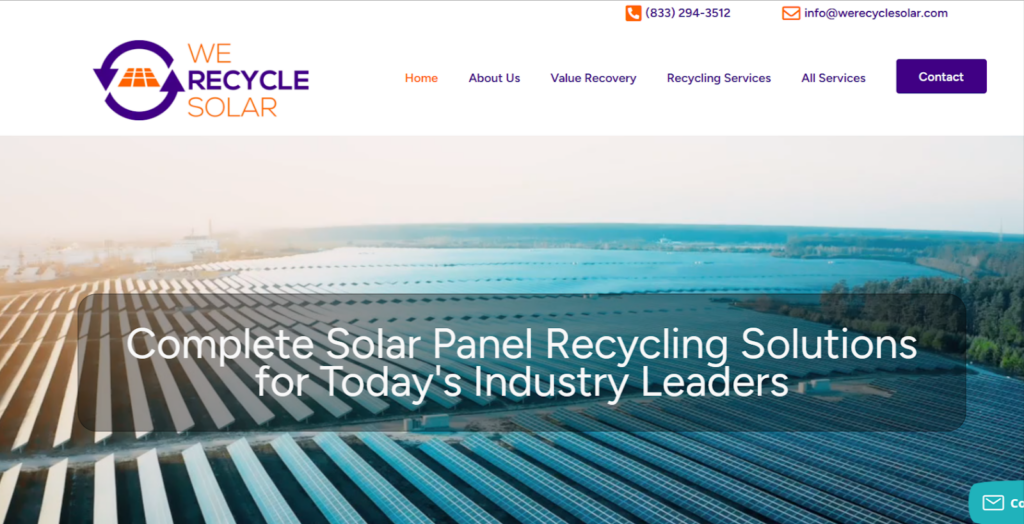
Solar panels have excellent longevity and can last up to 30 years and beyond. But there comes a time when a solar panel reaches the end of its useful life and has to be removed.
This is particularly true for the earliest models of solar panels, which, by now, are definitely nearing their expiry date.
So, what happens to solar panels that are declared defunct and need to be decommissioned?
Before, they were consigned to landfills and other inefficient and unsafe waste disposal methods. Nowadays, you’ll be pleased to hear efforts are being made to recycle them.
After all, why install an eco-friendly energy system if the end-of-life process for it isn’t eco-friendly?
In this in-depth article, we look at how the US is performing in the solar recycling sphere and answer your burning questions on this subject.
So, can solar panels be recycled? If so, how to dispose of solar panels safely?
Let’s find out.
In a Nutshell
- By 2050, there will be ten million metric tonnes of solar waste.
- Recycling rates for solar panels in the US will need to reach 95% or higher to avoid increases in raw material needs.
- The glass, aluminum, silicone, some plastics, and other metals in a solar panel can all be recycled.
- Overall, 95% of a solar panel can be recycled.
- High costs and lack of government policy create barriers to solar recycling.
- Right now, it costs $28 to recycle a single solar module. Placing it in a landfill costs $1.38.
- Star Solar Recycling is a solar panel recycling facility based in Denver, Colorado.
- Solar panels have a lifecycle of up to 30 years, so new installations won’t need recycling until around 2050.
Should We Recycle Solar Panels?

In short, yes. Old solar panels that have reached the end of their lifecycle can and should be recycled, but that doesn’t mean it’s easy or that it’s widely practiced across the USA.
However, the need for proper disposal of solar panels is becoming more urgent, especially now that the solar panels installed in the 90s and early 2000s have or are reaching the end of their lifecycle.
Moreover, in the past decade, solar energy has exploded in popularity with large-scale solar farms and residential and business solar installations popping up all over the place.
When these panels start reaching the end of their lifecycles, we are going to have a real problem on our hands if there is no way to dispose of the mountains of panels safely and in a sustainable manner.
It is estimated that by 2030, the materials that solar panels are composed of will consist of around $2.7 billion in recyclable materials, and as raw materials get scarcer and more expensive to source, unlocking this value will become crucial.
And, by 2050, it is estimated that there will be 80 million metric tons of solar panels across the globe that will be reaching the end of their lifecycle. Ten million metric tons worth of these will be located in the United States, reaching the equivalent weight of 30 Empire State Buildings!
Solar Panel Recycling: Progress So Far

Where Solar panel disposal is concerned, the US has a lot of ground to cover in comparison to its European counterparts. The US currently lacks laws and legislation around solar panel waste recycling, and as such, very little of it is done.
The EU Leads the Way
In the European Union (EU), solar panels come under its “Waste from Electrical and Electronic Equipment” (WEEE) directive, which mandates the separate collection and proper treatment of panels to minimize waste. In other words, you can’t just toss the old panels into a landfill.
The EU law now has a target of reaching an 85% solar panel recovery rate and an 80% recycling and reuse rate.
US Progress
In the US, no such targets have been made, although, in 2023, the Biden administration announced it was investing $20 million into optimizing the lifecycle of solar panels, including “streamlining the reuse and recyclability of solar panels.”
This funding will also be used to set up a “Solar Partnership to Advance Recycling and Circularity” to improve solar materials recovery and help develop safer end-of-life practices for solar installations.
US Analysis
The National Renewable Energy Laboratory (NREL) has been among the first to run a deep analysis of how recycling rates will affect the availability of solar panels once the grid is 100% decarbonized.
The analysis deduced that over 20 times the number of existing solar panels is needed to reach net-zero carbon energy.
While solar panels with longer lifespans will help reduce the need for new materials by about 3%, existing panels with shorter lifespans will need to reach a closed-loop recycling rate of 95% or higher if we are to avoid an increase in requirements for new materials.
The Emergence of Solar Recycling Plants in the US
Solar recycling is catching on in the USA, with a number of companies now offering the service nationwide or stateside.
We Recycle Solar is the country’s first utility-scale solar recycling plant, which was founded in 2019, and SolarCycle – a California-based company – opened its doors in 2022 and provides innovative and scalable technology that can extract and reuse 95% of a solar panel’s materials.
Which Components of Solar Panels Can Be Recycled?

Although a lot of different materials go into the construction of a solar panel, the good news is that most of it can be recycled. Here are the most common components that are harvested during the solar panel recycling process:
Glass:
- Solar panels are chiefly composed of glass and this material generally consists of around 75% of a solar panel’s total weight.
- The glass is durable and high-quality and doesn’t degrade after recycling, so it can be easily used again.
Aluminum Frames:
- Typically, aluminum frames are used to house and protect the solar cells in most solar panel designs.
- Aluminum is a highly recyclable material and can be repurposed multiple times without any significant degradation.
- Recycling aluminum uses only 5% of the energy required to produce new aluminum from raw materials, making the process especially eco-friendly.
Silicon Solar Cells:
- Silicon is used in most solar cells and can be monocrystalline, polycrystalline, or amorphous.
- Silicon cells can be treated with chemicals to reclaim them from the solar panel, which can then be refined and reused to produce new solar cells.
Other Metallic Parts:
- Small amounts of other metals, including silver, copper, and tin, are used as conductors in the solar panel.
- These metals can be separated from the solar panels and used in the production of new electronic components or other products.
Plastic Components:
- Plastics account for a very small portion of solar panels and are generally used for the backing layer of a panel and junction boxes.
- Plastic degrades significantly during recycling methods and is usually repurposed for downgraded products.
Which Components of a Solar Panel Can’t Be Recycled?
Despite most components in a solar panel being recyclable, there are a few elements that can’t be extracted and repurposed:
- Ethylene Vinyl Acetate (EVA): This substance is used to laminate solar cells for protection. EVA contains solar panel chemicals that are hard to recycle.
- Teflon: Some panel manufacturers use Teflon (the stuff that makes your frying pan non-stick) to create specific components. Removing and recycling this substance is challenging and costly.
- Certain metals: Metals such as lead and cadmium are hard to recycle because of their toxic and harmful properties.
- Certain Plastics: Although some plastic is recyclable, other types degrade during the recycling process to the point where it is not usable.
- Adhesives and Sealants: The substances used to hold everything together or to protect the panels are generally difficult to separate and recycle.
How Solar Panels Are Recycled

Recycling solar panels involves a number of complex steps to extract all the raw materials:
1. Collection and Transportation
First, the defunct solar panels are collected from various sites and delivered to the processing plant.
Safe handling of the solar panels is required to prevent any additional damage or environmental contamination.
2. Manual Disassembly
Manpower is required to disassemble the panels into separate components, including:
- The removal of aluminum frames
- The detachment of wiring and junction boxes
- Separation and removal of the glass layer
- Removal of the photovoltaic layers
The glass and aluminum require no further processing and can be taken away and repurposed.
3. Thermal Processing
The cell modules are now heated to 932°F which softens and separates the layers. During this process, the plastic covering evaporates and is repurposed as heat energy.
The silicon wafers are then removed, melted down, and reused., and the modules are cleaned and reused.
4. Chemical Bath
The solar cells, once separated and shredded, are placed in acid and peroxide. The solution removes the cell’s layers, which contain valuable metals like silver or aluminum. The resulting slurry contains semiconductor materials (often silicon) and metal traces.
5. Separation of Silicon and Metals
The slurry is then processed using precipitation and dewatering to separate the silicon from the metal components. Vibration techniques are deployed to remove interlayer materials, such as glass.
6. Refining and Purification
Finally, the separated materials are further refined and purified. This process removes impurities and ensures that the materials can be reused in the production of new solar panels or other products.
7. Waste Treatment
Non-recyclable materials are treated according to environmental regulations. Some might be incinerated, while others might be placed in a designated landfill.
What Are the Challenges in Solar Recycling?

There are two key challenges that hinder solar recycling’s progress in the US.
Firstly, the lack of regulations and laws around recycling is a challenge. There are no federal laws in existence that mandate the proper recycling of solar energy systems.
The impact of this is that it doesn’t incentivize businesses and manufacturers to make efforts to repurpose the solar panels they use or produce.
A handful of states have placed some regulation on the disposal of solar panels, but it is woefully inadequate and nowhere near enough to convince manufacturers and businesses to push forward with recycling:
- California: Solar panels are classified as hazardous materials and must be disposed of according to hazardous waste management regulations.
- Hawaii: Solar panels are classified as universal waste, which streamlines their management requirements.
- Illinois, Oklahoma, and Nebraska: These three states are the only ones that have solar panel decommissioning regulations.
- Colorado doesn’t currently have any regulations or classifications for solar panel waste.
The second big barrier to solar panel recycling is the cost. According to the National Renewable Energy Laboratory (NREL), recycling a solar panel costs in the region of $28 per single module. On the other hand, placing it in a landfill costs $1.38 per module.
This massive cost difference is a sticking point. As operational costs for businesses have risen, no one wants to spend more than they have to dispose of their unwanted equipment.
There is hope on the horizon, though. As newer technologies emerge, the cost of recycling photovoltaic systems will drop. In fact, scientists in Australia have recently discovered the humble microwave can make a huge difference in the ease of recycling.
And as the US government moves towards carbon-free energy, they will be forced to address the growing concern – and piles of waste – that decommissioned solar panels generate.
Solar Panel Recycling Near Me

If you are based in Colorado and have an aging solar system installed, you’re probably wondering how and where to recycle PV solar panels.
There are a few solar recycling companies that operate within the state, and they are as follows:
- Star Solar Recycling: Based in Denver, this company is SERI R2 and e_Stewards certified – two industry standards for recycling electronic waste.
- We Recycle Solar: This company provides decommissioning and recycling or utility or large-scale solar farms.
- SOLARCYCLE: Offers full solar recycling services to residential, commercial, industrial, and utility-scale solar installations.
If you’re yet to have your solar panels installed, then we greatly anticipate the arrival of more recycling facilities before they reach the end of their lifecycle!
Talk to 8760 Solar

Did you know that solar panels only decrease in efficiency by about 20% over the course of their entire lifetime? Some solar panels installed in the 80’s are still producing energy!
The point is, the lifecycle of a solar panel is long and you can enjoy the benefits of solar energy for several decades before you even have to start thinking about recycling them.
If you’re keen to get solar energy for your business, talk to our team at 8760 Solar. Text “READY” to 719 470-0254 or contact us via email: sales@8760solar.com and we’ll get back to you right away.
Frequently Asked Questions
Are Solar Panels Recyclable?
Yes! Solar panels are recyclable and around 95% of the components in a solar panel, including glass, aluminum, and silicone, can be repurposed for other uses.
What Happens to Old or Broken Solar Panels?
Old or broken solar panels are disposed of. Many end up in landfill sites or are taken to general-purpose recycling plants where their glass and metal frames are removed and recycled.
However, specialist solar panel recycling plants are now emerging, which have the capability to recycle 95% of the solar panel’s components.
Can Solar Panels Be Recycled Into New Solar Panels?
The glass, metal, and silicone can be removed from decommissioned solar panels, purified, and recycled into new solar panels.
Can I Buy Recycled Solar Panels?
Manufacturers of solar panels may use reclaimed materials in their new modules. To find out, you can contact the manufacturer or talk to your solar developer. You can also buy pre-used solar panels but this must be done with caution as they may not be as efficient as newer modules.
Is It Worth Recycling Solar Panels?
If we are to move to a sustainable future, then we have to start recycling solar panels. The sheer amount of reusable materials contained in a solar panel makes it worth recycling them.
